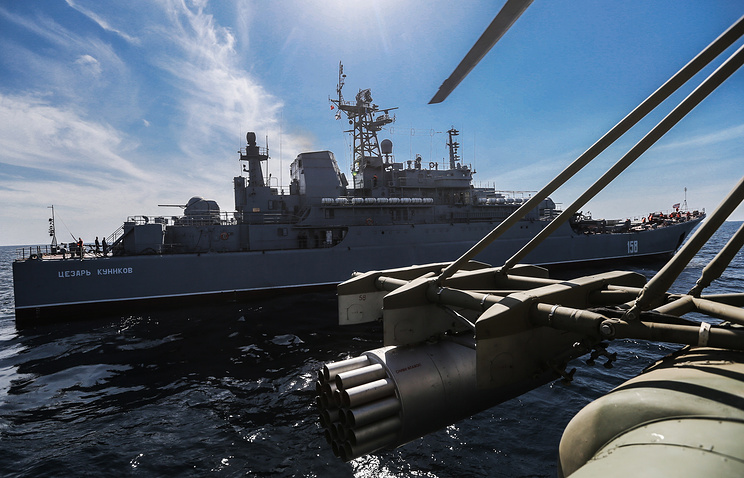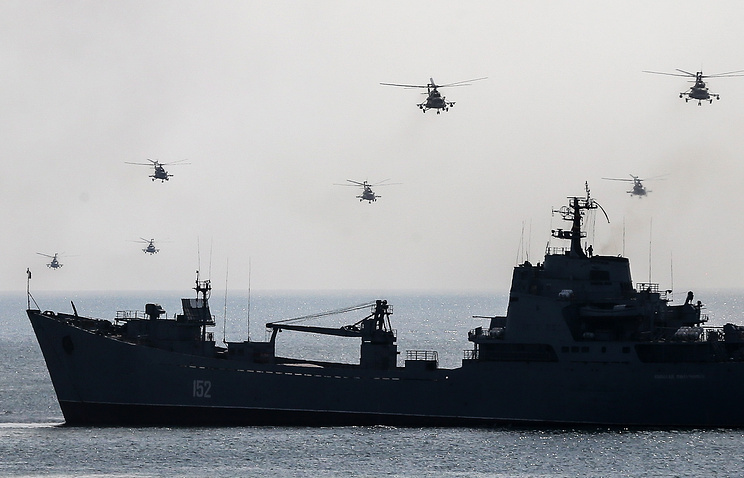14:05
Marines deploy on Crimean coast from Black Sea Fleet ships for drills - general (Part 2)
12:16
Il-76 planes airdrop some 350 Airborne Forces troops, 9 combat vehicles during drills in Crimea - general (Part 2)
https://sputniknews.com/military/201703211051803997-russia-crimea-drills/
The Russian military has launched a large-scale exercise at the Opuk training range, in Crimea. The drills involved the Russian Airborne Forces, the Black Sea Fleet and the Aerospace Forces.
Airborne Forces commander Col. Gen. Andrei Serdyukov told reporters that the drills involved over 2,500 airborne personnel and some 600 units of military hardware. Troops involved in the exercise were deployed to the peninsula by air, sea and railway on March 13-19.
"For the first time in the history of the Russian Army within the framework of Airborne Forces exercises, three of our divisions were simultaneously alerted and partially deployed in Crimea with authorized weapons and materiel," Serdyukov said.
The commander also said that during the drills airborne units are expected to practice anti-landing defense measures together with personnel of the Black Sea Fleet. They will also destroy simulated enemy inland positions and will secure Crimea’s "important frontiers" and areas.
Serdyukov also said that the main reason behind such a massive exercise in Crimea is the increased terrorist threat. He added that airborne units would also practice "resolving crisis situation in different parts of the world."
According to member of the Crimean regional parliament Vladislav Ganzhara, such a threat really exists.
"The threat is pretty much real. Last summer, Ukrainian sabotage groups planned terrorist attacks in Crimea. They were foiled by the Russian Federal Security Service. Moreover, taking into account Kiev’s hostile rhetoric towards Crimea, such drills are reasonable and necessary," Ganzhara said in an
interview with Radio Sputnik.
According to the lawmaker, the drills will also enhance the atmosphere of security in the peninsula.
"Crimea is very close to Ukraine where a military conflict is going on. Russia is conducting military drills on its own land and Crimea residents feel much safer. In terms of defensive capabilities, Crimea today is an outstanding region. It is Russia’s unsinkable aircraft carrier in the Black Sea," the lawmaker said.
OPUK RANGE/Crimea/, March 20. /TASS/. Drills involving three large units of Russia’s Airborne Forces, Aerospace Forces and the Black Sea Fleet began in Crimea’s Opuk firing range on Monday, Airborne Force Commander Colonel-General Andrei Serdyukov said.
"For the first time in the Russian army’s history the Airborne Forces’ three large units were simultaneously alerted as part of the drills and partly redeployed to Crimea with weapons and equipment," said Serdyukov, who is in charge of the manoeuvres.
More than 2,500 paratroopers and some 600 pieces of equipment are involved in the drills.
Servicemen from Novorossiysk, Kamyshinsk and Ulan Ude units, as well as the fourth army of the Aerospace Forces and Air Defense Forces of the Southern military district take part in the exercises.
During the drills, the troops will train to conduct operations "as part of a group of rapid reaction forces" against terrorists and regular forces of a simulated enemy, Serdyukov said.
The exercises are held in the new format in Crimea due to the "increased terrorist threat and also a broad range of use of the Airborne Forces as rapid reaction forces to solve crises in various regions of the world," he said.
The servicemen will be tasked to take under control crucial facilities, practice amphibious landing and airdrops, and also firing during the offensive and defensive operations
*********************************
http://tass.com/defense/936453
MOSCOW, March 20. /TASS/. The crew of the Black Sea Fleet’s landing ship The Caesar Kunikov will take part in a combined airborne troops exercise in Crimea, the fleet’s spokesman Vyacheslav Trukhachov told the media.
"In the course of the preliminary phase of the current command staff exercise of Russia’s airborne troops the crew of the Caesar Kunikov ship will practice boarding and landing on unequipped coast with airborne troops and vehicles also present. In the final phase of the exercise there will be an airdrop and amphibious assault operation at Crimea’s Opuk proving ground," he said.
The amphibious assault operation at the Opuk proving ground is due on March 21.
A combined military exercise involving three airborne units and also the Black Sea Fleet and Aerospace Force began in Crimea earlier on Monday.
More:
http://tass.com/defense/936453
******************
http://tass.com/defense/936611
"The amphibious assault landing of paratroopers of the Novorossiysk airborne force large unit onto the Crimean coast from the warships of the Black Sea Fleet has become the second episode of the practical scenario unfolding at the Opuk practice range today," the commander said.
At first, counter-sabotage boats delivered engineer reconnaissance groups to the coast to clear it of mines and ensure the safe landing of the amphibious assault main forces, he said.
"After the coast was cleared of mines and other explosives, two large amphibious assault ships delivered the main assault forces -
a battalion-level tactical group of about 300 servicemen from the Novorossiysk division," Breus said.
The troops delivered to the coast immediately engaged in a battle to defend the terrain and prevent the landing of an enemy amphibious assault group. Before the paratroops were landed, units of the Ulan-Ude air assault brigade seized a coastal sector to assist the landing of the main forces, after which they switched to coastal defense in that area.
Meanwhile, about
200 servicemen from the Kamyshin separate air assault brigade have landed from helicopters in the depth of the Crimean peninsula, Brigade Commander Colonel Alexander Valitov said.
"The landing of a tactical air assault group comprising artillery and air assault units of the Kamyshin separate air assault brigade from Mi-8 and Mi-26 helicopters has become the third episode of practical drills to simulate combat operations," the commander said.
"The troops were landed from the helicopters in an air assault manner, with the rotocraft hovering at a small altitude above the ground. Overall, about 200 our paratroopers have landed," Valitov said.
After their landing, the paratroopers active in the Dzhankoi direction have started to block and destroy sabotage and reconnaissance groups of a simulated enemy and units of illegal armed formations. They will also be inspecting cars and trucks and individual citizens in border areas.













